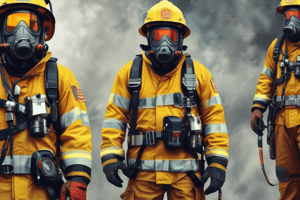Podcast
Questions and Answers
What is considered a significant exposure to a communicable disease according to the text?
What is considered a significant exposure to a communicable disease according to the text?
- Exposure to any body fluid
- Exposure through needle stick, instruments or sharps to specified body fluids (correct)
- Exposure to airborne contagions only
- Exposure to any bodily fluid with or without protection
Where should the Exposure Control Manual be available for all employees?
Where should the Exposure Control Manual be available for all employees?
- Local library
- HR department
- Fire Rescue Intranet site (correct)
- Public website
Who should be provided with adequate training on the Exposure Control Manual?
Who should be provided with adequate training on the Exposure Control Manual?
- All employees
- Only medical staff
- Personnel with potential for bio-hazard exposure during emergency operations (correct)
- Only management
What areas should the Exposure Control Manual provide information on?
What areas should the Exposure Control Manual provide information on?
What does a significant exposure to a communicable disease include?
What does a significant exposure to a communicable disease include?
Which one does not meet the criteria for requesting an HIV test?
Which one does not meet the criteria for requesting an HIV test?
Which body fluid is not listed as a significant exposure to a communicable disease?
Which body fluid is not listed as a significant exposure to a communicable disease?
What type of exposure is defined as significant?
What type of exposure is defined as significant?
What should the Exposure Control Manual be reviewed and updated to maintain?
What should the Exposure Control Manual be reviewed and updated to maintain?
Who should be provided with adequate training on the Exposure Control Manual according to the text?
Who should be provided with adequate training on the Exposure Control Manual according to the text?
Which type of exposure is not considered significant according to the text?
Which type of exposure is not considered significant according to the text?
What should the Exposure Control Manual provide information on?
What should the Exposure Control Manual provide information on?
What should employees do after significant exposure to airborne pathogens or body fluids?
What should employees do after significant exposure to airborne pathogens or body fluids?
When should post-exposure prophylaxis treatment be sought?
When should post-exposure prophylaxis treatment be sought?
What are the supervisor responsibilities regarding exposure documentation?
What are the supervisor responsibilities regarding exposure documentation?
Who is responsible for ensuring that exposed employees request source patient testing?
Who is responsible for ensuring that exposed employees request source patient testing?
What are the responsibilities of the Exposure Control Officer?
What are the responsibilities of the Exposure Control Officer?
What is the advice given to firefighters regarding chemical exposure?
What is the advice given to firefighters regarding chemical exposure?
What should be done if there is undue chemical exposure?
What should be done if there is undue chemical exposure?
What should Fire Rescue avoid using for training purposes?
What should Fire Rescue avoid using for training purposes?
How should chemical exposures be documented?
How should chemical exposures be documented?
Where should incidents be documented?
Where should incidents be documented?
Who should be provided with adequate training on the Exposure Control Manual?
Who should be provided with adequate training on the Exposure Control Manual?
What is considered a significant exposure to a communicable disease?
What is considered a significant exposure to a communicable disease?
Where should the Exposure Control Manual be available for all employees?
Where should the Exposure Control Manual be available for all employees?
What should the Exposure Control Manual provide information on?
What should the Exposure Control Manual provide information on?
Who is responsible for ensuring that exposed employees request source patient testing?
Who is responsible for ensuring that exposed employees request source patient testing?
What does a significant exposure to a communicable disease not include?
What does a significant exposure to a communicable disease not include?
When should post-exposure prophylaxis treatment be sought?
When should post-exposure prophylaxis treatment be sought?
What type of exposure is not considered significant according to the text?
What type of exposure is not considered significant according to the text?
What should employees do after significant exposure to airborne pathogens or body fluids?
What should employees do after significant exposure to airborne pathogens or body fluids?
What are the supervisor responsibilities regarding exposure documentation?
What are the supervisor responsibilities regarding exposure documentation?
What should be done if there is undue chemical exposure?
What should be done if there is undue chemical exposure?
What should Fire Rescue avoid using for training purposes?
What should Fire Rescue avoid using for training purposes?
What should employees do after significant exposure to airborne pathogens or body fluids?
What should employees do after significant exposure to airborne pathogens or body fluids?
Who is responsible for ensuring completion of forms and documenting the exposure in the appropriate sections?
Who is responsible for ensuring completion of forms and documenting the exposure in the appropriate sections?
What are EMS Captains responsible for in the event of exposure?
What are EMS Captains responsible for in the event of exposure?
What is the responsibility of the Exposure Control Officer?
What is the responsibility of the Exposure Control Officer?
What should firefighters do to avoid unnecessary exposure to chemicals and chemical by-products?
What should firefighters do to avoid unnecessary exposure to chemicals and chemical by-products?
What should be done in the event of undue chemical exposure?
What should be done in the event of undue chemical exposure?
Where should incidents of chemical exposures be documented?
Where should incidents of chemical exposures be documented?
What should Fire Rescue avoid using for training purposes?
What should Fire Rescue avoid using for training purposes?
When should post-exposure prophylaxis treatment be sought?
When should post-exposure prophylaxis treatment be sought?
What should the Hazardous Materials Unit be contacted for?
What should the Hazardous Materials Unit be contacted for?
What are the responsibilities of the Exposure Control Officer regarding affected employees?
What are the responsibilities of the Exposure Control Officer regarding affected employees?
What should be done after significant exposure to airborne pathogens or body fluids?
What should be done after significant exposure to airborne pathogens or body fluids?
Flashcards are hidden until you start studying
Study Notes
Occupational Exposure Protocol for Firefighters
- Employees should follow specific steps after significant exposure to airborne pathogens or body fluids, including cleaning the wound, notifying the EMS Captain, accompanying the source patient to the hospital, completing a Physician Notification Form, and advising the ER physician about the exposure.
- Post-exposure prophylaxis treatment should be sought within 1-2 hours, and employees should follow hospital guidelines and complete necessary forms.
- Supervisor responsibilities include ensuring completion of forms and documenting the exposure in the appropriate sections.
- EMS Captains are responsible for ensuring that exposed employees request source patient testing, coordinating with the hospital and Occupational Health Clinic, and completing necessary forms.
- The Exposure Control Officer is responsible for assisting affected employees, verifying completeness of forms, contacting the Occupational Health Clinic and Hospital Infection Control Coordinator, maintaining a confidential file on all exposures, and investigating the exposure.
- Firefighters are advised to avoid unnecessary exposure to chemicals and chemical by-products in their duties and to utilize protective equipment when handling hazardous materials.
- The Hazardous Materials Unit should be contacted for undue chemical exposure, and full protective clothing should be utilized in situations where exposure to chemicals exists.
- Fire Rescue should not use structures or vehicles containing asbestos or hazardous materials for training purposes.
- Chemical exposures should be documented on a Hazardous Substance Exposure Form and Supervisor Incident Report, and incidents should be documented in the FDM Firefighter Casualty Section.
Occupational Exposure Protocol for Firefighters
- Employees should follow specific steps after significant exposure to airborne pathogens or body fluids, including cleaning the wound, notifying the EMS Captain, accompanying the source patient to the hospital, completing a Physician Notification Form, and advising the ER physician about the exposure.
- Post-exposure prophylaxis treatment should be sought within 1-2 hours, and employees should follow hospital guidelines and complete necessary forms.
- Supervisor responsibilities include ensuring completion of forms and documenting the exposure in the appropriate sections.
- EMS Captains are responsible for ensuring that exposed employees request source patient testing, coordinating with the hospital and Occupational Health Clinic, and completing necessary forms.
- The Exposure Control Officer is responsible for assisting affected employees, verifying completeness of forms, contacting the Occupational Health Clinic and Hospital Infection Control Coordinator, maintaining a confidential file on all exposures, and investigating the exposure.
- Firefighters are advised to avoid unnecessary exposure to chemicals and chemical by-products in their duties and to utilize protective equipment when handling hazardous materials.
- The Hazardous Materials Unit should be contacted for undue chemical exposure, and full protective clothing should be utilized in situations where exposure to chemicals exists.
- Fire Rescue should not use structures or vehicles containing asbestos or hazardous materials for training purposes.
- Chemical exposures should be documented on a Hazardous Substance Exposure Form and Supervisor Incident Report, and incidents should be documented in the FDM Firefighter Casualty Section.
Studying That Suits You
Use AI to generate personalized quizzes and flashcards to suit your learning preferences.




